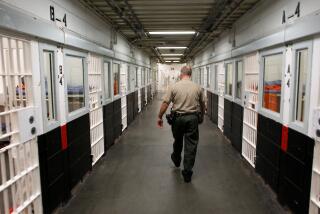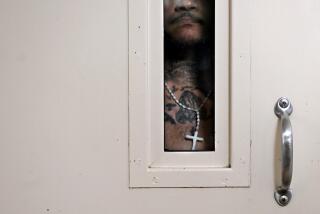As sheriff struggles to contain COVID-19 outbreaks, active infections in San Diego jails exceed 500

- Share via
SAN DIEGO — Nine months after the novel coronavirus took root in San Diego County jails, cases are continuing to spread, and employees and inmates say they are afraid for their safety.
The Sheriff’s Department is now reporting more than 400 active cases of the coronavirus among its inmates — or 11% of the total jail population. Hundreds of staff members also have been infected.
Some sheriff’s deputies say their commanders are not doing nearly enough to protect them from the virus. Some inmates say conditions inside the jails are fast approaching desperation.
“It’s horrible — horrible,” said one inmate who contacted the San Diego Union-Tribune this week. “We are on 24-hour lockdown. We get out for 15 minutes a day, when we can take a shower or use the phone.”
The detainee, who did not want to be identified due to fear of retaliation, said mail deliveries and television privileges had been suspended and that many members of the kitchen staff had been sent home. The inmates have been eating peanut butter and jelly sandwiches for weeks.
“We are hostages,” the inmate said.
The Sheriff’s Department said jail commanders were employing the best practices they could to stem the spread of the virus.
A spokesman also said the department had not experienced any widespread disruption to its food services operation and continued to offer a varied menu. He said moving inmates between facilities was necessary to manage the population.
“This is especially true during the COVID-19 pandemic,” spokesman Lt. Ricardo Lopez said by email. “The purpose behind general inmate movement between facilities is simple. There are not enough beds at our three intake facilities to keep all newly booked inmates there long term.”
Lopez said the department remained committed to inmate safety, health and welfare — and said only some “routine community-based medical appointments” had been deferred, either to limit possible exposure or because some outside clinics had closed due to the pandemic.
“As many community organizations and services have been impacted by the pandemic as well, we are working with our community partners to continue ongoing care and management plans, such as dialysis, HIV and oncologic evaluation and treatment,” he said.
According to data posted early this week on the Sheriff’s Department website, the total number of coronavirus cases has surpassed 1,000, including more than 500 active infections among inmates and employees.
A total of 757 inmates have been infected with the virus so far this year, the department said, including 414 active cases. Another 114 inmates have been placed into isolation, the department reported.
Among sheriff’s deputies and other staff, the number of cumulative positive cases has climbed to 316. Of those, 134 are active infections. The department said 181 employees had recovered from the virus and one person had died.
Early in the pandemic, the department teamed up with judges and lawyers to reduce the jail population, which dropped from about 5,500 early this year to fewer than 3,800.
But the structured release of inmates suspected of committing low-level offenses has largely stalled. The jail population Thursday was just over 3,750, and deputies continue to book offenders on relatively minor charges.
In a 24-hour period from Monday to Tuesday, for example, the Sheriff’s Department booked 11 people into custody, each on a single charge of being drunk in public, records show.
One sheriff’s deputy told the Union-Tribune that despite what department officials had stated publicly, jail commanders continue to expose employees and inmates to the virus unnecessarily.
“They have upped the protocols, but [they are] still moving inmates around, which we can’t understand,” said the deputy, who requested to remain unidentified because they were not authorized to speak to reporters.
“It’s the detentions’ upper command,” the deputy added, referring to the department’s Detention Services Bureau, which operates the county’s seven jails. “Big-time disconnect. Useless!”
The union that represents jail nurses and counselors said the escalating caseload was indicative of Sheriff Bill Gore’s response to the pandemic. The union said Gore’s response had been inadequate — and continues to put public health at risk.
“This is the outcome of critically low levels of understaffing medical services and subordinating the judgment of healthcare professionals to command staff,” said David Garcias, president of the local Service Employees International Union chapter, who is challenging the sheriff’s plan to outsource all medical services in his jails.
“The county should put COVID-19 response and containment in the jails under the Health and Human Services Agency,” Garcias said. “The sheriff’s negligence in this case shows he is unfit for command.”
The Sheriff’s Department has a history of not detailing which facilities have the most cases.
The Union-Tribune last month asked department officials about an outbreak it learned of at the George Bailey Detention Facility in Otay Mesa, the county’s largest jail. They issued a news release later saying that 55 inmates had tested positive and new protocols were being implemented to reduce infections.
“We do not underestimate the challenges we face to keep COVID-19 from entering San Diego County Sheriff’s Department jails and have taken immediate action to safeguard the lives of people in our custody and those who work in our facilities,” the release said.
Part of the department response, however, included moving some inmates to other jails — at least one of which also experienced a wave of new cases.
According to data obtained by KPBS and reported earlier this week, the outbreak at the George Bailey jail was the worst in San Diego County last month. The facility recorded no fewer than 149 cases in November.
The Vista Detention Center recorded the fourth-highest number of coronavirus cases last month at 81.
McDonald and Davis write for the San Diego Union-Tribune.
More to Read
Sign up for Essential California
The most important California stories and recommendations in your inbox every morning.
You may occasionally receive promotional content from the Los Angeles Times.













